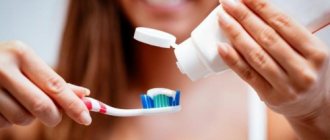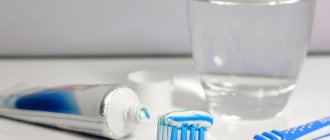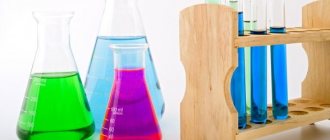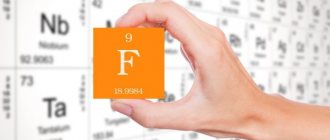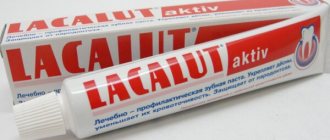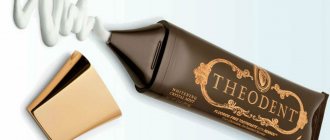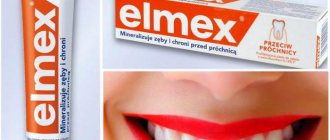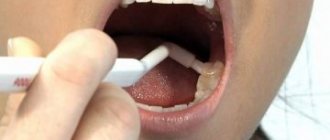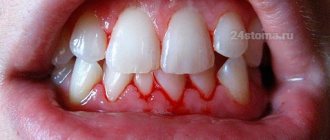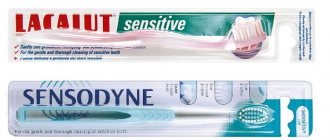Every person dreams of a snow-white smile, so they take special care in choosing the right toothpaste. The need for a competent choice of drug for dental care is due to increasingly diagnosed dental problems and deterioration in the quality of food and drink. Lakalut toothpaste, produced by the German company Dr., can cope with plaque on the teeth, which is the cause of caries and darkening of the enamel. Theiss Naturwaren Gmbh. The manufacturer produces a wide range of products. Thanks to this, each buyer will be able to find the best option for himself.
Some information about the manufacturer
The first pastes of the Lakalut series were presented by Dr. Theiss Naturwaren Gmbh in the 20s of the last century. The company, in addition to producing oral care products, also specializes in mass production and distribution of drugs. The company has subsidiaries around the world. Lakalut toothpaste is supplied to 52 countries around the world. It has won numerous positive reviews from dentists and consumers. In Russia, the product went on sale in the 70s of the 20th century and today has not lost its popularity. You can buy the drug at any pharmacy in the country.
Composition of the drug
The main component in Lakalut toothpaste is aluminum lactate, from which the name of the product comes. The component is especially useful for tooth enamel, as it saturates the upper layers of the tooth with essential salts and minerals. Lactate additionally has an anti-inflammatory effect and has astringent properties.
Other components included in the Lakalut paste include:
- Aluminum fluoride – protects enamel from caries and helps strengthen it.
- Chlorhexidine - inhibits the activity of pathogenic flora in the mouth and prevents the mineralization of dental plaque.
- Allantoin – stops bleeding gums and minimizes the severity of inflammatory processes in the oral cavity.
- Fluoride system. Strengthens tooth enamel and minimizes the impact of external irritants on it.
The harm of toothpastes! Detailed analysis of the composition. How to brush your teeth?
Before, I also never thought about what I use to brush my teeth—paste and paste, it cleans my teeth, what else do I need? And then I watched a video about modern toothpastes in the context of their impact on health and, impressed, began to further study the information on this issue. And then the other side of a beautiful tube of toothpaste . Since then, I have stopped using toothpastes... or rather mass-produced toothpastes. But don’t be alarmed, I continue to brush my teeth, and my hygiene is fine)))
By the way, many people think that if you delve into the composition of all food products, shampoos, creams, toothpastes, washing powders, etc. ... then everything, absolutely everything will turn out to be harmful! And you will have to give up everything. All that remains is to go into the forest - drink rainwater, eat the energy of the sun, brush your teeth with banana skins and wash with burdocks))) Therefore, it is better not to bother at all with health issues and live as you live. This is a position, and it has a right to exist. But I have a different approach, and I never tire of telling you that it is very simple - to live taking care of your health! There are a lot of useful products that are also convenient and pleasant to use! Over time, I have created a list of stores for myself where I buy everything I need - healthy food, cosmetics, etc. Of course, there are people who do it all with their own hands (like brushing your teeth with banana skins), but I live in a big city and I have no desire to turn a healthy lifestyle into fanaticism. From my point of view, all this (food, shampoos, pastes...) should be in the background. This is not what we live for. The main thing is to set goals, realize your talents, look for activities and people you like) So this is a big myth - that all vegans are fanatics, obsessed with food and choosing the right shampoo!
But let's get back to toothpastes. In this article I want to share with you what information I found about toothpastes:
- What is included in toothpaste?
- What could be the health risks of toothpaste?
- Is there such a thing as safe toothpaste? How to brush your teeth?
COMPOSITION OF TOOTH PASTE
In general, it is enough to look with the eyes of a layman at the composition of a standard toothpaste to understand that something is wrong here... Reminds me of a chemistry lesson - some incomprehensible chemical compounds. It is unlikely that you will be able to find anything natural there, and if there is any chamomile extract, it will be in last place with a share of 0.001%. This alone tells me that I don’t need such a paste. If I don’t understand what it consists of, then it turns out that I have to blindly trust the manufacturer... Somehow I don’t feel comfortable trusting Procter&Gamble, to be honest))) I can trust myself and my knowledge, or a loved one, but I can trust that that a giant industrial company took care of my health... it's a bit too much.
But this is an intuitive opinion. And we need facts, facts, facts...))) Let's see what toothpaste consists of and what it can mean:
Sodium lauryl sulfate (SLS).
Available in 99% of toothpastes on shelves, including premium format toothpastes (for example, Splat and Lacalut).
Sodium lauryl sulfate is the same as A-surfactant - anionic surfactants. I wrote in detail about A-surfactants in an article about the dangers of washing powders. Yes, yes, A-surfactants are included not only in most washing powders and detergents, but also in toothpaste! They are responsible for foaming and quickly removing stains. It is due to sodium lauryl sulfate that pastes foam so well and instantly clean teeth.
Attention! In addition to pastes, sodium lauryl sulfate is included in shampoos, shower gels, bath foam, cleaners, washing powders... Essentially, it is a cheap detergent obtained from coconut oil through chemical synthesis.
But at the same time, A-surfactants have a very aggressive effect on the body . Even through washing powder they are harmful to health. They are not rinsed out during washing and are retained in the fibers of the fabrics, and then through the fabric they enter the skin, and through the pores of the skin into the body, where they are carried through the blood to the organs and accumulate in the tissues of the liver, lungs, heart and especially the brain . Moreover, they are not completely eliminated from the body. They accumulate on cell membranes, covering them with a thin layer, and when a certain concentration is exceeded, they disrupt the integrity of the cell and lead to diseases - a weakened immune system (which in turn leads to frequent diseases and allergies), Alzheimer's disease, etc.
Let's think about it! If such processes occur in the body even with indirect contact (penetration into the skin through tissue), then what happens when we actually eat these toxic substances?! After all, it is known that the oral mucosa has a pronounced ability to absorb. The amount of A-surfactant in the paste is of course less than in the powder, but this amount is instantly absorbed. After all, the rate of absorption of substances in the oral cavity into the blood is 30 seconds!
Sodium lauryl sulfate dries out the oral mucosa and increases the sensitivity of the gums to allergens and irritants such as food acids. In addition, it is a very strong abrasive, the use of which leads to thinning of the enamel.
The following experiment was carried out - a participant in the experiment had his vision measured using precise modern equipment. He then brushed his teeth with SLS toothpaste and immediately had his vision measured again by a doctor. Surprisingly, vision immediately deteriorated by 5%. Then he repeated all the actions again. And after the second cleaning, vision deteriorated by another 2%! You will say - if there really was such an effect, then we would all go blind. But in fact, our body is designed in such a way that it is capable of self-healing and fighting external destroyers. Therefore, the body certainly removes some of the dangerous chemicals coming from outside. But, firstly, it cannot completely remove them and they slowly accumulate in the tissues. And secondly, this function of fighting chemicals is given to the body as an emergency function. The body is not designed to constantly eliminate poisons. And we brush our teeth constantly, 2 times a day!
Conclusion: Sodium lauryl sulfate is a dangerous toxic chemical. Choose a toothpaste that does not contain sodium lauryl sulfate. This can also be indicated by the inscription “SLS free”.
Sodium coco sulfate (SCS).
Sodium cocosulfate is also an A-surfactant. Moreover, this A-surfactant is included in many so-called natural and organic toothpastes. It's a great marketing ploy, but it's a scam. The fact is that the word “coconut sulfate” itself is associated among buyers with coconut, and coconut is healthy and natural! To be honest, I myself fell for this bait and bought one such eco-paste with sodium coco sulfate. But then I studied the information about this component of the paste and came to the conclusion that it is the same sodium lauryl sulfate, with all that it implies...
If you look at it, sodium lauryl sulfate is also made from coconut, but this does not make it any less toxic to the body. It is made from a fatty acid in coconut (namely lauric acid). This acid then reacts with sulfuric acid and then with sodium carbonate. The output is sodium luaryl sulfate, a toxic substance that is added to pastes.
On the other hand, sodium coco sulfate is also produced from coconut, but from several fatty acids. This set of fatty acids also reacts with sulfuric acid and sodium carbonate. The output is supposedly natural sodium cocosulfate. In fact, it is a substance very similar in properties to lauryl sulfate! Cocosulfate is essentially a mixture of the well-known sodium lauryl sulfate and several other compounds (sodium caprylic sulfate, sodium oleic sulfate, sodium stearyl sulfate, etc.).
Conclusion: Sodium cocosulfate is the same chemical as lauryl sulfate. Which undeservedly penetrated the ranks of ingredients for natural cosmetics. Therefore, we act in the same way - we buy pastes without this ingredient in the composition.
Fluoride.
Many people have already heard about fluoride in toothpastes. In recent years there has been a lot of noise about the health risks of excess fluoride, and not just from toothpastes!
Fluoride is added to toothpaste to prevent caries. Indeed, in the 1940s, American scientists first discovered the ability of fluoride to heal holes in teeth. But it turned out that the principle “we treat one thing, cripple another” applies. Unfortunately, a common principle in modern medicine... So, it turned out that an excess amount of fluoride leads to the opposite effect - namely, the destruction of tooth enamel, joint problems, the formation of kidney stones, the destruction of bone tissue (even osteoporosis and bone cancer) . According to some studies, fluoride can also cause damage to brain tissue similar to Alzheimer's disease and other forms of dementia.
Recommended doses of fluoride:
- for an adult - 1.5 - 2 mg per day ,
- for a child over 4 years old - 1 mg,
- for a child 1-3 years old - 0.7 mg,
- for a baby under 1 year - 0.5 mg.
- up to 6 months External fluorine is not needed at all.
Manufacturers of toothpastes usually comply with these standards. But the thing is that, in addition to toothpaste, fluoride is found in a huge number of products. For example, there is a lot of fluoride in tea (both black and green), especially in cheap bagged tea. One sachet contains about 1.5 mg of fluoride (data from Food Research International), that is, already about the daily requirement for an adult!!! Keep in mind that as the strength of the brew increases, the fluoride content increases! It is generally better not to drink bagged tea, or any very strong tea, and not only because of fluoride. I wrote about this in an article about tea.
Fluoride is also found in fish, seafood, rice, oatmeal, buckwheat, potatoes, apples, grapefruits, walnuts... For example, 2 large apples are about 0.5 mg of fluoride, 100 g of walnuts are 0.68 mg of fluoride. Portion 200 gr. salmon or trout is 0.9 mg of fluoride. In addition, fluoride can be added to muesli, cereal, soda, fruit juices, canned food...
But we consume most of the fluoride in our water – bottled and from the tap! Fluoride from water is most easily absorbed by the body. Moreover, fluoride is added artificially to water. This is the so-called fluoridation process by adding one of three substances to water: sodium fluoride (powder), fluorosilicic acid (liquid) or sodium fluorosilicate (powder). Surprisingly, the purpose of fluoridation is to reduce the incidence of tooth decay! What concern on the part of the state! What if I don’t want to get artificial fluoride from water, but want to get it only in its natural form from products? (read about the dangers of artificial vitamins in the article about synthetic vitamins). It’s sad, but they didn’t ask us... Moreover, fluorine is one of the most difficult elements to filter. Not every filter retains fluoride, and if it does, you have to change the filter cassette very often.
How much fluoride is in tap water? Each region and city has its own water composition. For example, for Moscow it is about 0.2 mg of fluorine per liter, for the Moscow region - about 0.5 mg/l. There are cities where fluoride in water is off the charts - these are Krasnogorsk (3 mg per liter!!!), Odintsovo (1.8 mg/l), Vidno and Podolsk (1.2 mg/l ), Tver (0.8-2 mg/l).
Countries where water fluoridation is prohibited: Austria, Belgium, China, Czech Republic, Denmark, Finland, France, Germany, Hungary, India, Israel, Japan, Luxembourg, Holland, North. Ireland, Norway, Scotland, Sweden, Switzerland.
Let's try to calculate how much fluoride can be obtained per day from food and water. Let's say we drink 2 liters of water a day and we don't have a special filter that can retain fluoride. This is 1 mg of fleet (let's take the average content of 0.5 mg/l). Plus 2 apples. This is 1.5 mg of fluoride. Plus some other little things - for example, buckwheat or rice... So it turns out to be 1.5-2 mg per day, that is, the norm for an adult.
Moreover, we must also take into account that we receive some of the fluoride when we take a shower! After all, the skin absorbs liquid over its entire surface, and during a shower we can absorb up to 1.5 liters of water!
In general, we get enough fluoride even without toothpaste, and sometimes even more than normal . We obviously don’t need additional, and artificial, fluoride from toothpaste! I want to emphasize that fluoride in itself is not bad! It is present in our body and we additionally consume it with various foods and water. It's just too much in toothpaste!
A sign of obvious fluoride excess is, for example, bleeding gums and the appearance of white spots on the teeth. Then these spots turn gray or brown and the process of tooth decay begins. This is already a visible stage of the disease. Why bring it to her? Isn't it better to give up toothpastes with fluoride so as not to provoke the onset of a problem?
Be careful! Just because the toothpaste doesn’t say “with fluoride” doesn’t mean it’s not there ! Look carefully at the ingredients. Fluoride can be hidden in toothpastes under the following names:
- monofluorophosphate
- sodium fluoride
- tin fluoride
- aminofluoride
The number of fluoride ions may also be written on the pastes. For example, “the content of fluorine ions is 1176 ppm. In this case, ppm is the number of particles per million (eng. - parts per million, ppm). So, conventionally, pastes are divided into the following categories:
with a high fluorine content (> 1000 ppm) with an average fluorine content (500-1000 ppm) with a low fluoride content (< 500 ppm) without fluorine But you and I know that fluoride-free toothpastes are best!
Conclusion: Fluoride is an extra component of toothpaste, which, if the daily norm is exceeded, also causes a number of diseases. Choose toothpaste without fluoride and its compounds.
Triclosan.
This is an antibiotic. Yes, yes, a real antibiotic! So don’t rush to say that you don’t take antibiotics))) At least with toothpaste you get your dose every day!
In addition to triclosan, these can be metronidazole, chlorhexine, bisabolol, biclotymol, etc.
Antibiotics are added to the toothpaste to kill germs in the mouth. The problem is that this destroys not only harmful bacteria, but also beneficial microorganisms that live in our mouths and are an integral part of our health. It is these beneficial bacteria that are designed to fight parasites and microbes, and not antibiotics in the paste! This happens in the following way: during the life of beneficial bacteria, substances are released that inhibit the growth and reproduction of harmful microorganisms: staphylococci, E. coli, etc.
Therefore, by killing the bacteria we need, we upset the balance in the body, destroying our natural “healers”, without which we become constantly dependent on antibiotics. It turns out to be a vicious circle. Over time, the beneficial microflora of the mouth weakens so much that without antibiotics it can no longer cope with its main task - not allowing harmful bacteria further into the body. This leads to dysbiosis.
There is also an opinion that triclosan is harmful to pregnant women, as it can interfere with blood flow to the uterus, which in turn causes oxygen starvation of the fetus. This does not mean that the fetus will immediately suffocate because of the toothpaste, it will just be at least uncomfortable for him...
Conclusion: Antibiotics destroy the natural microflora of the oral cavity and thereby cause harm to health. They have no place in a safe toothpaste!
Aluminum lactate.
Aluminum lactate, or lactic acid salt, is a type of aluminum salt. It is added to the paste as an anti-inflammatory substance that stops bleeding gums. It also reduces the sensitivity of teeth (to cold, sour, hot and sweet), affecting the nerve endings of the tooth and preventing the transmission of signals from external stimuli to the nerve. A favorite component of Lacalut pastes.
There are a lot of natural components that perform similar functions, but it is more profitable for large manufacturers to use aluminum salts. It's a matter of economics...
What are the health risks of aluminum salts? I touched on this topic in an article about salt (it turns out that aluminum is also added to table salt!). The fact is that aluminum is well absorbed and deposited in the body ... in the bones, liver, testes, parathyroid gland, but mainly in the brain. This leads to degeneration of some brain cells and ultimately to diseases - memory impairment, impaired motor function, Alzheimer's disease and other brain-related diseases.
In addition, an excess of aluminum salts prevents calcium retention in the body , inhibits hemoglobin synthesis and reduces the absorption of phosphorus and other trace elements. This can lead to problems with bones and joints (osteoporosis, fluorosis and other diseases). As for pregnancy, there is evidence that aluminum crosses the placenta and accumulates in the tissues of the fetus, which can cause various developmental disorders. For example, experiments were conducted on mice, during which such results were obtained. If, during pregnancy, aluminum lactate was administered to mice for 7–15 days in an amount of up to 10 mg/kg/day, this would lead to a decrease in the efficiency of task performance in the rat pups and an increase in the delay time.
And during experiments on rats, the following was noticed - fluoride, even in minimal quantities, leads to an acceleration of the absorption of aluminum into the brain tissue. And, as we know, in most toothpastes fluoride and aluminum live next door! It happens like this: fluorine reacts with aluminum, forming aluminum fluoride, which is able to overcome the protective (so-called blood-brain) barrier of the brain. That is, aluminum fluoride penetrates through this barrier into the brain, depositing in nerve cells. Source - Conference of the Russian Academy of Medical Sciences, topic "Alzheimer's disease and aging: from neurobiology to therapy." 1999
Conclusion: Aluminum salts accumulate in the body and especially in the brain! At high concentrations, it leads to a number of diseases related to the brain and more... Toothpaste with aluminum lactate is not worth the risk to your health!
……
To be honest, the list is not complete. These are the most basic and most harmful ingredients in toothpastes. This list could be continued for a very long time, since the variety of chemicals in pastes is amazing! But let's stop there. Personally, this is already enough for me to think and draw conclusions...
List of other, less toxic substances.
There are a number of substances that cannot be unambiguously classified as harmless components in pastes. But they do not belong to the particularly toxic substances listed above. These are, so to speak, components of average harmfulness) They can be treated differently. It can be considered that their presence is not acceptable, since it is better to refuse to use anything that could potentially (although this has not been proven) have a bad effect on health. But you can come to terms with them, since their harm has not been proven by anyone and therefore these substances are included in even organic natural toothpastes.
At one time I was categorical and refused to use any pastes, because there was something dubious in each of them. And I started using natural tooth powders. But I didn’t like the powders and I began to use them not as the main means for cleaning my teeth, but as an addition to toothpastes. Read about this in my article “Review: Natural Toothpastes and Powders.” In general, I decided to come to terms with some of the individual components of the pastes from the list above, but with the following conditions: 1- the paste should contain a maximum of 2 components from the controversial list, 2- these components should be in last place in the composition, 3- I will look for dental pasta with 100% natural ingredients, and if I can’t find it, I’ll study all sorts of ways to make such a paste at home.
Here are examples of such controversial substances:
- Sodium carboxymethylcellulose (sodium CMC) is a stabilizer obtained from cellulose and soda. Improves the viscosity and consistency of the paste. It is also a food additive E466, approved in the EU and the Russian Federation. When consumed in large doses, some people experience: allergies, skin irritations, stomach upsets, increased cholesterol... However, it is not clear at what doses and why such effects occurred, because the permissible norm for humans has not been determined anywhere by anyone. But this additive is not allowed for baby food, and this is a sign! And this substance is not broken down in the body.
- Saccharin (Sodium Saccharin) is a synthetic, not natural sweetener. Remember the cans of sweetener pills that dieters and people with diabetes were once addicted to? So, this is saccharin. It is not absorbed by the body. Approved as a food additive in the USA, Russia, and EU. It is believed that at a dose of 5 mg per 1 kg of body weight, saccharin is harmless. However, some scientists consider it carcinogenic in any dose. That is, there is no consensus.
- Titanium dioxide (tanium dioxide, CI 77891) . This is an illuminator that gives pastes a perfectly white color. This substance is considered harmless, since it is supposedly not absorbed at all by the walls of the digestive tract and is eliminated from the body without problems. However, studies conducted on mice suggest otherwise. Regular inhalation of titanium dioxide led to the development of cancer in mice. The fact is that the particles of this substance are so small (nanoparticles) that they can penetrate into the blood, and from it into various organs, where they destroy the cell membrane. There were also cases of DNA and chromosome damage in mice that received titanium dioxide nanoparticles in their drinking water for 1.5 years. But it should be noted that during these studies, mice received a very high concentration of dioxide every day. A person does not receive similar doses through the paste, that's for sure.
- Cocamidopropyl betaine - gives the paste thickness and foam. Made from fatty acids from coconut oil. It is considered an anionic surfactant (A-surfactant), and therefore can cause allergic reactions (skin irritation, peeling, itching...) and inflammation of the mucous membrane. But the effect of this A-surfactant is definitely softer and better compared to sodium lauryl sulfate, which is used in mass-market pastes! It is believed that this substance has a bad effect on the liver and thyroid gland due to its carcinogenicity. However, this is controversial, since other studies show that the release of carcinogens occurs only at temperatures above 350 degrees. The FDA (the American federal committee responsible for product safety) recognizes cocamidopropyl betaine as safe for external use and when applied to the skin for a short time (which also applies to pastes).
- Sodium lauroyl sarcosinate is also an A-surfactant, and also more gentle than the commonly used sodium lauryl sulfate. In my articles I wrote a lot about surfactants. These are harmful toxic substances that are used in washing powders, toothpastes, shampoos and other hygiene products. To remove dirt and foam. Research shows that sodium lauryl sarcosinate has significantly less aggressive health effects than sodium lauryl sulfate. And unlike many other surfactants, it easily decomposes and therefore is environmentally friendly. Although, of course, it is not a gift either. It is believed that a healthier alternative to Cocamidopropyl Betaine and Sodium Lauryl Sarcosinate are the so-called glucosides . For example, coco glucoside is a mild A-surfactant made from coconut pulp and fruit glucose. And decyl glucoside is a mild A-surfactant that is made from fatty glucose derived from corn starch and coconut fatty acids.
It would be better, of course, for these substances not to exist anywhere at all. After all, they are not natural. And I don’t believe in 100% safety of unnatural chemicals. It often happens that today a chemical is supposedly harmless, but after 5 years it turns out that it leads to health problems. Any substances artificially removed in laboratories are foreign to our body and it will strive to get rid of them. Therefore, it is necessary to strive to minimize the use of chemical compounds of unknown origin.
HARMFUL TOOTHPASTE
The fact that all the chemical compounds listed above are harmful to health is half the problem. What's really hard to wrap my head around is that they are all gathered together in one beautiful tube of toothpaste. It turns out that such toothpaste is not a product for caring for teeth, but a toxic mass dangerous to health.
Some may think that I have embellished everything here. But no. For the purpose of writing this article, I took Lacalut toothpaste from a neighbor, and then went to the pharmacy and analyzed the composition of all known toothpastes - from cheap to expensive. Absolutely all pastes contained several or all of the dangerous ingredients! You can do your own research...
You may say, but we don’t eat toothpaste! Firstly, as I wrote just above, the oral mucosa miraculously absorbs all substances. Therefore, some part of the toothpaste is absorbed into the blood through the mucous membrane of the oral cavity and spread throughout the body, reaching internal organs and tissues... Secondly, we literally eat part of the paste.
During a lifetime, a person eats an average of 2.5 kg of pasta. And children generally love to specifically swallow pasta that smells like strawberries, bananas and all sorts of delicious things. The child swallows ¼ of the toothpaste at one time! So you need to be especially careful when choosing pasta for children.
To summarize, it turns out that toothpaste harms both directly the teeth, bones and joints (due to fluoride, aluminum salts and sodium lauryl sulfate), as well as the immune system and the main organs of human life. For example, the gastrointestinal tract suffers from antibiotics (triclosan, chlorhexidine and the like), in general any chemicals that, by definition, cannot be safely absorbed by the gastrointestinal tract. The liver and brain are negatively affected by sodium lauryl sulfate, fluorine and aluminum salts.
Yes, and I also want to add that mass-produced mouth rinses are also a toxic mass , only in liquid form. I won’t write about them separately. Everything is similar here - it contains chemicals that are hazardous to health.
HOW TO BRUSH YOUR TEETH WITHOUT HARM?
It may seem that there is no way out, because only such pastes are sold in stores... There are many different brands, but the composition is always chemical. But I have good news - natural cleaning products exist, and in a fairly wide variety))) They are simply sold in other stores, because they cannot compete with mass brands for space on the shelves of large supermarkets... Manufacturers of natural pastes do not produce products on such a gigantic scale and they do not have a multi-billion dollar budget to promote the product. But they have a wonderful composition of natural ingredients and the gratitude of those who use them))) And this is not little!
For a detailed report on what teeth cleaning products I use, read the article: REVIEW “NATURAL TOOTH PASTES AND POWDERS.” From the article you will find out which dental products I liked the most and why. And also how much they cost and where they can be purchased.
In the meantime, I will briefly describe how, in principle, you can brush your teeth safely, without fear for your health. There are 3 main options:
Option number 1 - powder from the store
Buy tooth powder containing only natural beneficial ingredients. What do I mean by natural ingredients? Everything here is extremely simple - you read the ingredients and if all the ingredients are familiar to you from childhood, then this is a natural powder. If strange names appear that resemble chemical compounds from chemistry lessons, then this is not what we need... There are several manufacturers of such powders - Russian and foreign. They are sold in popular health food and cosmetics stores. Also always available in Hindu Ayurvedic shops.
Option No. 2 - handmade powder
Make your own powder at home. It's not difficult at all. You can find recipes on the Internet or look at the composition of powders from stores (see point 1) and reproduce something similar at home. The cooking process is extremely simple. There is no need to boil anything in a water bath, soak it, etc. You just buy everything you need and mix it in a convenient jar.
Option No. 3 - almost natural paste
This is the most common option to use. Because the powder does not foam and is not always convenient to take with you on the road. And the pasta is free of these two disadvantages. But the paste is not so ideal in composition. No, of course it does not contain any of the dangerous, toxic substances that I wrote about in detail in this article. But there cannot be 100% natural ingredients here, otherwise the consistency will not be so smooth and uniform, the color will not be so pleasant, etc.
But the unknown compounds in such pastes are usually made from natural ingredients and do not cause serious harm to health. For example, sodium silicate may be found. This is a food additive E-550, which is produced from natural materials, for example, from silicon-containing raw materials. This is a substitute for harmful aluminum silicate. Or xylitol - a plant sweetener that is naturally found in fibrous vegetables and fruits, corn cobs and birch bark. For a detailed list of ingredients in natural toothpastes that have scary names but are actually harmless, see the article: “Review: Natural Toothpastes and Powders.”
Such pastes may also contain less natural substances. These are usually 1-2 controversial components, which some consider harmful, while others consider safe. For example, sodium CMC (sodium carboxymethylcellulose) is an E-466 food additive made from soda and cellulose. Or sodium saccharine (sodium saccharine) - food additive E-954. Sweetener of synthetic origin. For a detailed and clearly presented list of such controversial components of toothpastes, see the article: “Review: natural toothpastes and powders.”
By the way, the “correct” pastes are sold in the same health stores and Hindu shops. They can also be found in homeopathic pharmacies.
CONCLUSIONS.
Only you can decide which option suits you best. I would advise you to first buy a toothpaste with a good composition, so that giving up harmful toothpastes will go completely unnoticed. And only then experiment, try other options... If you wish!
By the way, toothpastes appeared in people’s everyday life relatively recently, a little over 100 years ago. Dentist Washington Sheffield came up with a tube in 1892))) The idea with tubes took off, and since then the paste has completely replaced all other means of cleaning teeth. Before toothpaste, people used tooth powders. I saw them actively used in childhood. And before purchased powders, people in the old days made such powders themselves - from ash, salt, roots... Hindus made and continue to make powders from herbs and even their dried ground banana skins))))
Source
Advantages of the product
Products from Dr. Theiss Naturwaren GmbH is certified and meets international quality standards. You can find the relevant documentation on the manufacturer's official website.
Lakalut is classified as an anti-inflammatory paste due to the inclusion of aluminum lactate (or lactic acid salt) in its composition. The advantages of the product include the following characteristics:
- The widest range of products based on the individual needs of certain categories of customers.
- The presence of medicinal plants in the extract, which guarantee a gentle and effective effect on the tissues of the oral cavity.
- Availability of children's oral care products in the line.
- Compliance of pastes with all safety requirements.
- Reducing the risk of developing carious processes with regular use.
Lakalut Active
So, the Active series includes 3 toothpastes:
- Lacalut Active;
- Lacalut Active Herbal;
- Lacalut Aktiv intensive cleansing.
Lacalut Aktiv toothpaste is positioned as a preventative agent that protects against periodontitis, strengthens the gums, reduces their bleeding, and at the same time prevents the development of caries.
Thus, Lakalut Active toothpaste is intended primarily for problem gums, and can act as both a preventive and therapeutic agent.
The composition shows that the main anti-inflammatory components are aluminum lactate, bisabolol and allantoin. In such a triple combination it’s a pretty good option.
We invite you to familiarize yourself with the best children's toothpastes
It is also worth paying attention to the presence of a powerful antibacterial component - chlorhexidine. The fact is that too long-term use of powerful antiseptics can lead to dysbiosis of the oral cavity (in fact, this is the same thrush, the only difference being that it develops in the mouth). Perhaps this is why the manufacturer recommends using Lakalut Active paste only in courses (30-60 days).
Separately, it is worth noting the presence of sodium lauryl sulfate in the composition, around which there has recently been a lot of talk about its “terrible” harm to human health: this compound is credited with almost carcinogenic properties. However, most of the dangers are greatly exaggerated, but this substance, apparently, can still contribute to stomatitis, so it is strange that the manufacturer has not replaced this substance with an alternative.
Thus, by purchasing Lakalut Active toothpaste, the consumer receives a wide range of therapeutic and preventive effects:
- Antiseptic;
- Anticarious;
- Anti-inflammatory;
- Hemostatic;
- Increased resistance of tooth enamel to acids (due to fluorides);
- Strengthening the enamel structure (also due to fluorides);
- It also reduces the painful sensitivity of teeth and gums.
According to studies (and reviews from people), after about 1-2 days of use, Lakalut Active toothpaste can reduce bleeding gums.
The second product of the Active series is Lacalut Aktiv Herbal: based on the paste described above, but with the addition of herbal extracts (chamomile, eucalyptus, star anise, thyme, sage, myrrh, mint and fennel). Thus, the anti-inflammatory and wound-healing properties of this product can be considered more pronounced.
And the third product in the series - Lacalut Aktiv Intensive cleansing - with a high content of surfactants that cleanse plaque from teeth. It is also characterized by higher foaming.
Types of adult pastes
The range of Lacalut pastes is presented in adult and children's series. There are about 20 types of Lakalut pastes intended for adults. They differ from each other in the level of abrasiveness, auxiliary components and purpose.
Lakalut asset
The product was created for preventive purposes. It helps strengthen the gums and reduce their bleeding during brushing teeth and eating food. The main indications for the use of Aktive paste: gingivitis in acute and chronic form, increased bleeding of gums, periodontopathy, prevention of carious processes, soft and hard plaque on enamel.
The instructions for use say that the product can be used in courses (up to 6 days in a row). Otherwise, resistance of the pathogenic flora to the components of the drug may occur; in other words, the effectiveness of the product will be reduced.
When treating dental diseases, it is advisable to alternate Lakalut active with other pastes in this series, for example, Fitoformula or White Alpin.
There are several therapeutic properties inherent in Lakalut Active paste:
- homostatic;
- antiseptic;
- restorative;
- anti-caries.
The paste contains chlorhexidine, which has a bactericidal effect and helps remove soft plaque on the surface of the teeth.
Which toothpaste is best for brushing your teeth?
A few words should be said about Lakalut Aktive Herbal paste, which additionally includes medicinal herbs:
- star anise chamomile;
- fennel;
- fennel oil;
- eucalyptus oil;
- sage.
Laculut Aktive Herbal paste is intended for people with loose and weak gums. Negative changes in periodontal tissue occur as a result of constant exposure to external factors: fungal pathogens, lack of vitamins in the body, toxic effects of food or medications. Gum diseases are accompanied by the formation of abrasions and ulcers on them, and increased bleeding. Thanks to its natural composition and complex effects, Laculut Aktive Herbal suppresses inflammatory processes and reduces the risk of developing periodontal pathologies.
Lakalut Active paste has some restrictions in its use, which is due to the presence of antiseptic components in its composition. With prolonged use, the drug may change the pH of the oral cavity. The product is available in tubes of 30, 50, 75 and 100 mg. The price of pasta varies between 130–190 rubles.
Lakalut Phytoformula
The composition of the product in this series includes sodium bicarbonate, sodium fluoride, chlorhexidine, aluminum lactate and other components. The advantage of the drug is that it contains extracts of medicinal herbs: myrrh, sage, St. John's wort, green tea. Lakalut Phytoformula does not contain aggressive components that could cause irritation of the oral mucosa: antiseptics, large abrasive particles, antibiotics. For this reason, the drug is approved for daily use.
Dentists recommend using the drug Fitoformula for bleeding gums, for the prevention of caries and to combat plaque, which turns into stone over time. Plant extracts cope well with the signs of periodontal inflammation and normalize the pH balance of the oral cavity and inhibit the activity of pathogenic flora that causes caries.
Dentists advise using Fitoformula paste together with Lakalut Active between courses. For example, use Fitoformula in the morning, and Active in the evening, or vice versa.
The therapeutic effect of using Lakalut pastes can be enhanced if you use Fresh or Active mouth rinses in combination with them.
Lakalut Phytoformula is sold in plastic tubes of 50, 75 ml. The cost of one unit of goods varies from 180 to 200 rubles. Store the paste at a temperature of 2 to 20 degrees.
Basic
The BASIC product has a complex effect on the oral cavity: protective, tonic, antiseptic. After using the gel, fresh breath remains for 10–12 hours, which is due to the inhibition of the activity of pathogenic microorganisms.
In addition to the classic mint taste, the series also includes pastes with the aroma of citrus, black currant, and ginger. Lakalut Vasic pastes are considered one of the most effective in preventing tartar.
Sensitive
The drug is specially intended for people with sensitive periodontal tissues. Another indication for use of the product is cervical caries, therapy after whitening. The main component of the drug is amino fluoride, which is rarely used by other toothpaste manufacturers due to its high cost.
After using Lakalut Sensitive, there is a decrease in the susceptibility of tooth enamel and gums to cold and hot foods. The drug is also used for course therapy for up to 60 days.
White
The gel contains a large number of abrasive components that carefully and delicately clean the enamel from food debris and plaque, whitening it several tones. An additional advantage of the product is that it contains substances that increase the resistance of oral tissues to pathogenic bacteria.
The main difference between Lakalut White paste and other oral care products is the absence of hydrogen peroxide in the composition, which can cause irritation of the mucous membranes.
New – White and repair paste. It helps whiten enamel, strengthen it and prevent caries.
Fluor
A distinctive feature of the series is the increased fluoride content in a dosage that is harmless to adults. This gel should be used only after consultation with a dentist. Among the properties of the drug, one can note an increase in the resistance of enamel to acids and other external irritants. In combination with Lakalut Fluor pastes, it is recommended to use a remineralizing gel.
Whitening toothpastes Lakalut
Lakalut toothpastes from the White series are positioned as whitening and capable of returning (restoring) the natural whiteness of a smile. An important point is that you should not expect that these products, like hydrogen peroxide, will lighten tooth enamel: no, in this case we are talking about mechanical lightening of the surface of the teeth by removing various pigmented deposits.
Thus, if your enamel is naturally yellow, spotted or even brown, then you will not be able to get a snow-white Hollywood smile.
So, the White line includes whitening pastes:
- White – basic product;
- White{amp}amp;Repair – in addition to whitening, it provides a remineralizing effect, that is, it saturates tooth enamel with mineral components;
- White Edelweiss – here the “highlight” to the whitening effect is the presence of extracts of alpine edelweiss, sage, mantle and verbena. Due to this, pronounced anti-inflammatory, wound healing and antioxidant effects are achieved;
- White Alpenminze – with alpine mint extract for maximum fresh breath.
For example, the Lacalut White whitening toothpaste has an abrasiveness index of RDA 120, that is, slightly above the average value, therefore it cleans the enamel quite carefully and in some cases is suitable even for sensitive teeth (for which, generally speaking, the use of whitening pastes is often undesirable due to... thinned enamel).
The presence of pyrophosphates in the composition, which are effective complexing agents, allows you to gradually destroy the tartar matrix by extracting calcium ions from it. However, it should be understood that this sometimes has a negative effect, since calcium will also be extracted to some extent from the surface layer of tooth enamel. That is why the use of toothpastes with pyrophosphates is usually not recommended for people with sensitive teeth.
Not without the presence of sodium lauryl sulfate in the composition of Lakalut White - the possible harm of this substance was noted above. And in addition to it, there are also preservatives methylparaben and propylparaben, the dangers of which are also controversial today.
In general, we can say that the composition of the paste is well suited for those people whose teeth are fine, but have plaque or tartar. Although even in this case, the manufacturer recommends using the product in courses - no more than 4 weeks.
The price of Lakalut toothpastes with a whitening effect is about 250-350 rubles.
Children's series
Let's look at several oral care gels from Dr. Theiss Naturwaren Gmbh, which are designed to care for children's teeth:
Baby. Can be used by children under 4 years old and has a pleasant raspberry taste. The drug is suitable for daily use by children and is safe if accidentally swallowed. Instead of fluoride, the drug contains amino fluorides - substances that have a gentle and gentle effect on the mucous membranes of the mouth. The approximate cost of the product is 165 rubles.
Kidz is a paste for children aged 4–8 years. The product takes into account all the features of a milk bite, which is gradually replaced by a permanent one. It contains high-quality abrasive (silicon dioxide), which does not react chemically with fluorine. The cost of a 50 ml tube of paste varies from 140 to 170 rubles. To increase the effect of hygiene procedures, the manufacturer has additionally developed a mouth rinse, which is similar in composition to Lakalut Kidz paste.
How to use
The manufacturer of Lakalut paste indicates in the instructions that it is suitable for daily use. During hygiene procedures, you need to apply a small amount of gel to the brush (about the size of a pea). Excessive amounts of toothpaste will result in active foam formation, which may interfere with effective teeth cleaning.
Each series of Lakalut pastes has its own description for use:
- The active is used in courses of 30–60 days during an exacerbation of gingivitis or bleeding gums.
- Sensitive can also be used for 1–2 months. For sensitive teeth, this product is recommended to be combined with Lakalut Alpip toothpaste or Fluor, which provides additional enamel protection.
- White. The whitening product is allowed to be used for no more than 4 weeks. The level of abrasiveness of the drug is 120, after its use they switch to products with a lower level of cleaning ability with an indicator of 75.
- Basic. Used in combination with the Sensitive or White line of products. For example, in the morning they use a drug with a basic effect, and in the evening - a whitening one.
The duration of hygiene measures using Lakalut paste is 2–3 minutes. During the procedure, it is also necessary to pay sufficient attention to the gums and tongue. Brush movements are performed vertically: from the neck of the tooth to its cutting edge. First, the elements of the upper dentition are processed, then the lower ones.
Main ingredients of toothpaste
- Abrasives: aluminum hydroxide (Al (OH)3), calcium carbonate (CaCO3), hydroxyapatite (Ca5 (PO4)3OH).
- Fluorides: sodium fluoride (NaF), tin fluoride (SnF2), sodium monofluorophosphate (Na2PO3F).
- Surfactants: Sodium lauryl sulfate (SLS) or related surfactants (detergents).
- Antibacterial agents: triclosan or zinc chloride.
- Flavors.
- Remineralizers: hydroxyapatite nanocrystals and various calcium phosphates.
- Various other ingredients: glycerin, sorbitol or xylitol; 1,2-propylene glycol and polyethylene glycol; strontium chloride or potassium nitrate.
Customer Reviews
Oksana: Lakalut Active paste allowed me to cope with the problem of bleeding gums, and my husband - to reduce the sensitivity of the enamel to external irritants (cold, heat, sour, sweet). The previously used toothpaste did not help us cope with such problems. We purchased 3 types of products for ourselves and use each as needed (for treatment or prevention).
Sergey: I’m surprised how different the lines of the Lakalut series are. For me, the Basic and Alpin products turned out to be absolutely useless, while Extra Sensitive and Multi Effect allowed me to cope with some dental problems and tartar. None of the drugs relieves enamel sensitivity so well. Unpleasant sensations from eating cold and hot food disappear a few days after starting to use the paste.
Elena: I have suffered from tooth sensitivity since I was young. The only salvation from the problem for me is Lakalut Sensitive and Active pastes, which I use alternately. I use the first product during the day, the second in the evening. She noted a high effect from using mouth rinses from the same company. These products especially help with incipient problems with gum pockets.
